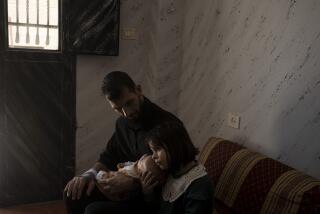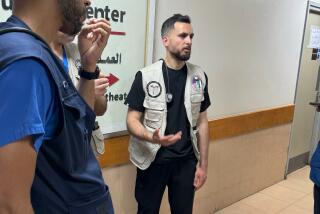When Israel Spoke to the PLO : MINE ENEMY <i> by Amalia and Aharon Barnea, translated from the Hebrew by Chaya Amir (Grove Press: $17.95; 210 pp.) </i>
For readers who do not skip forewords and acknowledgements of books, the name Salah Ta’mari, the protagonist of “Mine Enemy,” might ring a faint bell; or, rather, sound a faint drumbeat. In his foreword to “The Little Drummer Girl,” John Le Carre writes: “My host in Sidon, the Palestinian military commander Salah Ta’mari, deserves a book to himself, and I hope one day he will write it.” Ta’mari has not yet written his version of “the theatre of the real” (to use Le Carre’s words), where he keeps being drummed in and out, so to speak, by those who cross his winding paths, his entrances and exists to and from their lives. In late June 1982, Ta’mari says to Aharon Barnea, an Israeli radio correspondent, as their first meeting is ending: “If you could find my friend David Cornwall, tell him I’m sorry I didn’t have time to read the manuscript.” Cornwall being--but of course--John Le Carre to his friends; and the “manuscript”--”The Little Drummer Girl,” to be published a year later. Amalia and Aharon Barnea, the co-authors of “Mine Enemy,” prove to those who have read “Drummer” that with friends like Le Carre, Ta’mari is desperately in need of enemies like the Barneas.
On June 6, 1982, Israel invaded southern Lebanon in what was euphemistically called “Operation Peace for Galilee.” Two weeks after the fall of Sidon, a harbor city midway between the Israeli border and Beirut, the spokesman for the IDF (Israel Defense Forces) called Aharon Barnea, the correspondent for Arab affairs at the Israeli radio, and told him: “We’ve got the commander (of the kids who operate the RPG (rocket propelled grenade) missiles). Want to interview him?” “What’s his story?” Barnea asked, and the spokesman told him that the commander had given himself up in Sidon and was willing to talk to the media. So Lt. Col. Salah Ta’mari, the commander of the Fatah Youth Organization and a member of the executive committee of the Fatah in Lebanon, had a good excuse then for not reading the bulky manuscript of Le Carre.
For Barnea, a fastidious, choosy reporter in times impacted with news, Sidon was ancient history, now that the IDF was in East Beirut. As for the RPG (rocket-propelled grenade) kids, Barnea writes, “they were already old hat and I, personally, had had my fill of PLO prisoners. They all told you the same story--each with his own brand of excuses.” So he pushed the story to the back burner for a week, though Ta’mari was the senior-most Fatah member ever to have fallen into Israeli hands, and apparently the first one who wanted, voluntarily, to talk to the Israeli media. Barnea eventually set out to interview him, and the meeting, which was supposed to be just a brief interview, lasted for hours on end. “I had forgotten what time it was. All I knew was that the man had captivated me and I hung on his every word.”
This first, crucial meeting is delineated down to its minutest details in the first chapter of this book. For it was this broadcast interview that incurred a controversy among the besieged PLO fighters in West Beirut. “Do you think or feel or believe that the period of armed struggle is over?” Ta’mari is asked, and he adamantly answers that, practically speaking, it was, “at least for the next few years.” “In other words,” Barnea strikes while the iron is still hot, “you think the political struggle is more important now?” “Armed struggle may continue in some other form, but it’s bound to be to our disadvantage. That’s why I favor political action and political struggle . . . I gave 18 years of my life to the struggle . . . I’m not retiring, just switching channels.” One cannot help but wonder: Was Ta’mari a trial balloon launched by the PLO six years before the release of the position paper by Abu Sharif, adviser to Arafat, on the eve of the Arab summit conference in Algiers last June? “Mine Enemy” does not raise this possibility.
The “switching channels” interview, one has to bear in mind, was broadcast over Israeli radio, both in Arabic and English, at a time when West Beirut was under the seven-week siege (June 26-Aug. 12) that ended with the withdrawal of the PLO from the city. Rashid Khalidi, an Arab history professor at the University of Chicago who was in the city at the time, points out, in his “Under Siege: PLO Decision-Making During the 1982 War” (Columbia, 1986), that “the Israeli and Phalangist radios, whose information line was obviously closely coordinated (according to Ma’ariv, an Israeli evening newspaper, June 17), lost credibility as the war continued . . . Their news broadcasts sowed false rumors, made exaggerated claims of Israeli advances on the ground and alleged sweeping secret PLO concessions.” All efforts were being directed toward stampeding the PLO into agreeing to leave Beirut unconditionally.
Even Ta’mari himself would write in his prison diary, on Sept. 3, 1982: “The wealth of distorted and inaccurate news broadcast by the Israeli media is making Israel look like an Arab country.” So why would the “seniormost Fatah member ever to have fallen into Israeli hands” put his trust utterly in the hands of an Israeli radio correspondent and of his wife, who works for the daily Yedi’ot Aharonot? “Mine Enemy” answers this question in a rather captivating way.
Salah Ta’mari was born in Bethlehem (as As’ad Suleiman) in 1942, to a large, poor family from the Bedouin tribe of Ta’mara. When he was 13, he was shooed away one day from Bethlehem Plaza by some policemen who were busy setting up police barriers: Queen Dina, King Hussein’s first wife, was visiting the city. She was later to become Ta’mari’s wife. In “Mine Enemy” she plays a major role, albeit behind the scenes, in the prisoners’ exchange operation between Israel and the PLO in November, 1983. She adds a touch of class, though overdone at times, to this touching story about the impossible friendship between two families across the firing line. It would be interesting to read her version of the story in her forthcoming book, “Duet for Peace” (Quartet Books, distributed by Salem House).
Salah Ta’mari came to the public fore in the Middle East as the leader of the POW Ansar camp in southern Lebanon. He had already been in the hands of the IDF when this notorious prison camp was officially opened July 14, 1982. And as a coup de theatre, Ta’mari was brought to Ansar on his 40th birthday. More than 10,000 Palestinian and Lebanese prisoners were “rounded up” in it for different periods, costing the state of Israel about $1 million a day. Fourteen months later, on Nov. 23, 1983, there were 5,000 prisoners in it, and they were exchanged for the six Israeli prisoners held by the PLO. Ta’mari was appointed as the official representative of the PLO prisoners in the negotiations that led to the exchange. He was the last to leave the camp, after 500 days in Israeli captivity.
Aharon Barnea is at his best in the Ansar chapters. He picks passages from Ta’mari’s prison diaries, cross-examines them with the help of the camp commanders and brings the camp to life with his meticulous treatment of small details. Amalia, on the other hand, is the one who sticks to the low key of the encounter with Ta’mari, who “somewhere along the line . . . had become a person with a name and individual history, no longer just another anonymous terrorist--so much easier to hate.”
In the eyes of most Israeli Jews, the image of the Palestinian throughout the last two decades has been that of a black-and-white-checkered kufiyya, covering the head of a terrorist. It was as if there was under every head-dress a ticking bomb. So the only meetings between Jewish Israelis and Palestinians took place on both ends of a trajectory, or across the bars of a prison door. In this book, Amalia and Aharon Barnea unveil the kufiyya check-by-check in order to reveal the human face behind it, not to count down the bomb ticks. And their job is easy, since Ta’mari hardly wears any headdress.
At some point, before Ta’mari is taken to Ansar, the prison warden says to him: “Tell me, Salah, have you ever thought about which one of us is the prisoner here?” “Mine Enemy” is a captivating tale about captives and counter-captives gazing at each other through bars of their own making, a place where stereotypes are being cultivated across two cells in that huge prison of vehement struggle otherwise referred to as the Middle East.
More to Read
Sign up for our Book Club newsletter
Get the latest news, events and more from the Los Angeles Times Book Club, and help us get L.A. reading and talking.
You may occasionally receive promotional content from the Los Angeles Times.








